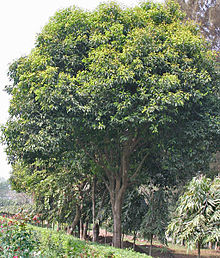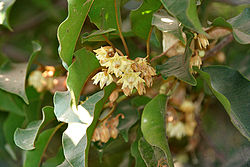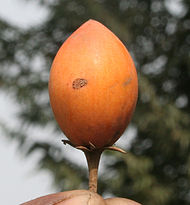- Mimusops elengi
-
This article is about a species of flowering plants called Medlar. For other uses, see Medlar.
Mimusops elengi 
Scientific classification Kingdom: Plantae (unranked): Angiosperms (unranked): Eudicots (unranked): Asterids Order: Ericales Family: Sapotaceae Genus: Mimusops Species: M. elengi L. Binomial name Mimusops elengi L. Mimusops elengi is a medium-sized evergreen tree found in tropical forests in South Asia, Southeast Asia, and Northern Australia. English common names include Spanish cherry,[1], Medlar[1], and Bullet wood. Its timber is valuable, the fruit is edible, and it has traditional medicinal uses.
Contents
Tree description
 Flowers in Hyderabad, India.
Flowers in Hyderabad, India.
Bullet wood is an evergreen tree reaching a height of about 16 m. It flowers in April, and fruiting occurs in June. Leaves are glossy, dark green, oval shaped, 5–14 cm long and 2.5–6 cm wide. Flowers are cream, hairy and scented. Bark is thick and appears dark brownish black or grayish black in colour, with striations and a few cracks on the surface. The tree may reach up to a height of 30–60 ft with about 1 m in circumference.
Ayurvedic uses
The bark, flowers, fruits and seeds are astringent, cooling, anthelmintic, tonic, and febrifuge. It is mainly used in dental ailments like bleeding gums, pyorrhea, dental caries and loose teeth.
Extract of flowers used against heart diseases, leucorrhoea, menorrhagia and act as antiduretic in polyuria and antitoxin. The snuff made from the dried and powdered flowers used in a disease called Ahwa in which strong fever, headache and pain in the neck, shoulders and other parts of the body occurs.
Ripened fruits facilitates in burning urination. The ripe fruit pounded and mixed with water is given to promote delivery in childbirth. Powder of dried flowers is a brain tonic and useful as a snuff to relieve cephalalgia. Decoction of bark is used to wash the wounds.[clarification needed]
Other uses
- The edible fruit is softly hairy becoming smooth, ovoid, bright red-orange when ripe.
- The wood is a luxurious wood that is extremely hard, strong and tough, and rich deep red in color. The heart wood is sharply defined from the sapwood. It works easily and takes a beautiful polish. Weight is 63 lbs per cubic foot.
References
- Brock, J., Top End Native Plants, 1988. ISBN 0-7316-0859-3
Wikimedia Foundation. 2010.

